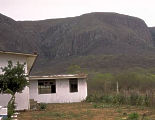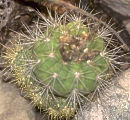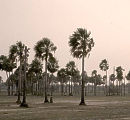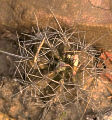|
Gymnocalycium chacoense H. Amerhauser
In the gorges of Cerro Miguel, Helmut Amerhauser and his companions found a new globose-cactus within inaccessible area, in 1995. At this time, it's not been possible to take any photographs because of the steepness of the mountains. Amerhauser re-visited this place in 1998.
Here an extract of the report by H. Amerhauser (published in Gymnocalycium 12/4/1999).
Amerhauser: " In the autumn in 1998, we hadn't had any breakdowns with our vehicles on this ride but ran into the danger of being arrested or shot. About 100 km away from our intitial position Robore, after we identified ourselves when passing a border guard near Paraguay, there suddenly approached an armor-plated vehicle with heavily armored soldiers, who immediately pointed their weapons at us. Apparently, they mistook us for smugglers or perhaps even spies and we had to endure another, much more stricter control. "
But they managed to convince the commander that they only were harmless plantfriends. At the Fortin Ravello the travellers were taken up friendly and got the possibility to stay overnight at the checkpoint.
|
photos by H. Amerhauser
|

|

|

|

|
| Cerro Miguel |
G. chacoense |
El Palmar |
G. griseo -pallidum |
Amerhauser: " On the next day we decided to ascend the mountain near our camp. To protect us from the many jaguars living here in the Campo, we were accompanied by a group of soldiers under the personal leadership of the commander. The soldiers knew a path through this overgrown area of man-tall bushes and a narrow path which led us to the peak of the Cerro. We discovered the first plants sought after in half height of the mountain. We were really surprised to find thousands of them in groups of 30-40 heads. Also striking was the uniformity of the plants with nearly no recognizeable trace of variety. Due to lack of gen-exchange the here living population presumably reproduced itself mainly vegetative. This theory is supported by the low germinates the seed of our sowings showed. "
|



